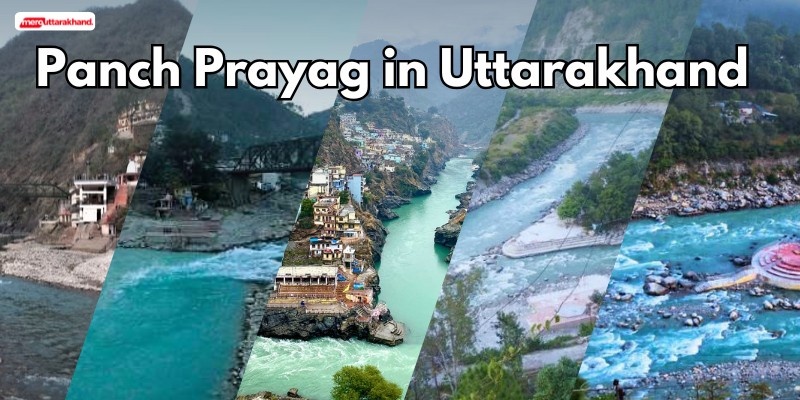Panch Prayag in Uttarakhand-The Five Holy Sangams
Kajal, 2 months ago, 5 min read, 19 Views

Overview
Panch Prayag refers to five sacred locations in Uttarakhand where five rivers combine to form the holy Ganges (Ganga) River (‘panch’ means five and ‘prayag’ means confluence with Hindi). The Ganges, one of the holiest rivers in India, is used in religious rites and is revered as the goddess of life. Vishnuprayag, Nandaprayag, Karnaprayag, Rudraprayag, and Devprayag are these five locations, listed in decreasing order of river confluence. The five locations are visited by devotees from all across the nation who think that dipping in the water there purifies the soul and bring one closer to moksha.
Hindu legend states that Goddess Ganga possessed great power when she descended to Earth. It was believed that she was divided into 12 channels to lessen her power, and that these channels eventually reunited to form the River Ganga again after Devprayag, the point where the rivers Alaknanda and Bhagirathi converge.
The town called Panch Prayag in Uttarakhand shows the people’s love for rivers in the sense that numerous bathers in this place do it as a way of seeking atonement from their sins. It is thus where river Alaknanda meets with rivers Dhauliganga, Nandakini, Pindar, Mandakini and Bhagirathi in Uttarakhand while river Ganga, Yamuna and Saraswati meet at Prayagraj. Referring to the Skanda Purana, five of them seen flowing down from snow-capped mountains are what are called the Prayags.
The Story of Panch Prayag
Based on Hindu legend, Goddess Ganga desired to bless humanity from the Earth, but Earth could not withstand her force. Knowing this, Lord Shiva made the decision to divide her energy and disperse it equitably throughout the nations. He channeled her energy through twelve channels into Earth, encasing it in His matted locks. It is said that these channels re-join following Devprayag, the final Panch Prayag that gives birth to the sacred Ganga River. For this reason, the Devprayag is considered the most significant of the Panch Prayags.
The Ganga is formed at the holy Devprayag site, where the Satopanth, Bhagirathi, Alaknanda, Vishnuganga, Dhauliganga, Nandakini, Pindar, and Mandakini converge at various points along the way.
The Panch Prayag of Uttarakhand
The five holy confluences, also known as prayags, can be found in the state of Uttarakhand on the Alaknanda River. Each of these prayags provides its visitors with deep spiritual experiences, having unique origins and significance
Vishnuprayag
Vishnuprayag (1372 m) is home to the ancient Vishnu Kund temple. It is formed by the confluence of the impetuous Vishnu Ganga (after this point known as Alaknanda) and the Dhauliganga River. This holy place is supposed to have been the place where the sage Narad worshipped Lord Vishnu. While flowers on the banks evoke the colors of nature in all her grandeur, visitors will find Kagbhusandi Lake to be enchanting with its emerald green depths giving it a quiet surface. By way of Vishnuprayag, which is next to Bhundhar hamlet, near Ghangaria, one can also reach the lake.
Vishnuprayag is a well-liked travel destination for adventure lovers due to its trekking and hiking paths, in addition to its religious significance. There are several well-known hikes, including as Hemkund Lake, Kagbhusandi, and the Valley of Flowers.
Nandaprayag
The Alaknanda River meets the Nandakini River at Nandaprayag, where they combine to form one stream. The popular and spiritual importance of Nandaprayag is enormous. Following a massive fire ritual also known as yajna which is said to have been performed by King Nanda in other to appease the gods, it is said that the gods came down because of His deep devotion and the sacredness of what he gave to them.
Hence, the existence of such concepts as in mythology as “Nandaprayag” which was named after King Nanda. Additionally, there is the well-known Gopalji temple, which honors Lord Krishna, located there.
Karnaprayag
Two sacred rivers, the Alaknanda and the Pindar, converge in Karnaprayag, which is situated on the route to Badrinath. According to legend, Karna from the Mahabharata spent many years meditating here in order to obtain the unbreakable shield that allowed him to be a fierce fighter in battle.
It is also known that Swami Vivekananda and his followers meditated here. It serves as the district Chamoli’s sub-divisional headquarters. From this location, roads lead to Jim Corbett National Park, Almora, and Nainital.
Rudraprayag
Rudraprayag, named for Lord Shiva (Rudra), is a small pilgrim town that is revered as one of the five sacred confluences, or the “Panch Prayag,” and sits on the holy confluence of the rivers Alaknanda and Mandakini. The Mandakini and Alaknanda river confluence has a certain beauty all its own; it like two sisters giving each other a hug. It is thought that in order for Narad Muni to comprehend the mysteries of music, he had to worship Lord Shiva, who then blessed Narad by coming to earth in his Rudra Avtaar avatar. There is significant religious significance associated with the Shiva and Jagdamba temples. Rudraprayag was formerly a part of Tehri and Chamoli district.
Rudraprayag was created as a new district in 1997 by combining the Kedarnath Valley with portions of Tehri and Pauri districts. This is the point of convergence for trips to Kedarnath Dham and Badrinath. Rudraprayag is home to a number of temples that are well worth seeing, the most well-known of which being the Koteshwar Mahadev Temple, which is located near the Alaknanda River. This lovely cave-temple, shrouded in dense greenery, is devoted to Lord Shiva, who is thought to have paused and meditated here.
Devprayag
The final prayag, or confluence, is Devprayag (850 m), a holy town in Uttarakhand’s Tehri Garhwal region. The sacred River Ganga is formed at Devprayag by the confluence of the Alaknanda and Bhagirathi rivers. The small town is located along the road that leads from Rishikesh to Badrinath. The literal meaning of Devprayag is “holy confluence.” For Hindus, this is a very significant place of worship.
From Devprayag, the Ganga, the largest and most sacred river in India, begins its trek through the plains and on to the Bay of Bengal. An earthquake in 1803 damaged the entire town, but the historic buildings of Devprayag were quickly rebuilt, preserving the holy town’s age-old splendor.
How to Get There
By Road: There are excellent road connections between all five Prayags and a number of Uttarakhand’s major towns and hill stations. There is excellent road communication between the Prayags and the cities of Rishikesh, Kotdwar, Dehradun, Haridwar, and other notable hill destinations in the Garhwal and Kumaon regions.
By Air: The five towns are roughly 239 km away from the Dehradun airport.
By Train: Rishikesh is the nearest train station to the five Prayags and serves the most populous cities in India very well.
Conclusion
In conclusion, the spiritual journey to all the Panch Prayag in Uttarakhand is an extremely rewarding adventure. Each of the Prayag is unique and, therefore, compounds myth, history and beauty within its environment. The celestial confluence of rivers at Vishnuprayag and the peacefulness of Nandaprayag provide just some of the great spots to see.
The divine Prayags of Karnaprayag and Rudraprayag with their charm abound in spiritual stories while Devprayag serves the purpose of forming the holy river Ganges by joining the rivers. Follow this divine calling; allow the Prayags to infuse into your heart their celestial healing energy.
Related FAQs
What is Panch Prayag significance?
The term Panch Prayag, also known as Paűcha prayāga, refers to the five holy river confluences in Uttarakhand, India’s Garhwal Himalayas.
What is Prayag?
Prayag is the term that Indians use to refer to the meeting points of rivers particularly in sacred settings. Here, the word “pra” stands for before or in front of while “yag” symbolizes a ritual or religious offering in the Sanskrit language. This is where the word “Prayag” originated.
Prayag is very important in Hinduism because these occasions are considered sacred and lucky. They are often related to The Rivers’ confluence symbolizes sacred union of God. Pilgrimage sites, religious ceremonies, and celebrations.
What is the story behind the Panch Prayag in Uttarakhand?
According to Hindu mythology, Goddess Ganga wanted to bless humanity from Earth, but Earth was powerless against her. Acknowledging this, Lord Shiva decided to split her energy and distribute it fairly among the countries.
Which Panch Prayag confluence is the deepest?
The deepest Prayag among the Panch Prayag (five confluences) in Uttarakhand is called Devprayag. Compared to previous Prayags, this one is considerably deeper. It should be noted that there is currently no evidence regarding the depth of Devprayag. But unlike other Prayags, this one is thought to be larger, with a depth of between 30 and 40 meters.
When is the ideal time to travel to Panch Prayag in Uttarakhand?
During the months between April and October, it is highly recommended for one to visit the Panch Prayag locality of Uttarakhand because this is when it has the most favorable climate for those who love outdoor sports or recreational purposes in addition to moving from one place to another during the corresponding periods of time.

Fill this easy form




